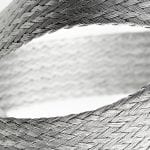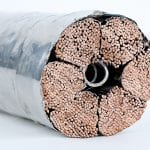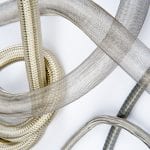When used in medical devices, wires and cables must meet exacting standards developed to ensure that the finished products will always perform as intended, with infinitesimal failure rates. Nowhere are those requirements more stringent than for invasive devices which have come to play a central role in both diagnostic and therapeutic applications for a wide range of diseases and conditions.
To get a better idea of the capabilities needed to meet such high standards, we recently spoke with Mike Tkalcic, Project Design Engineer here at New England Wire Technologies to learn more.
Q: In terms of the attributes that customers typically specify, how would you compare the requirements for medical products to those for other types of products?
A (Mike T.): The requirements for medical devices are more complex and often more demanding than those of nearly any other industry. Depending on the complexity of the device, developers may need to specify not only the basic physical attributes of the cable, like size and shape, but also their biocompatibility profiles, flexibility, lubricity, flex-life, performance after sterilization, and other characteristics. Obviously electrical performance is also critical.
Q: The attributes required for cables used in medical applications may be specific to a particular product, or even a particular model. What kind of medical products are the most demanding?
A (Mike T.): Cables that have stringent electrical requirements. Many advanced medical devices require signal wires to carry high-end video signals, and they are being expected to perform at higher and higher frequencies. Signal integrity is critical, so the wires are expected to function perfectly – even after physical abuse, such as being run over by a hospital gurney. Electrical characteristics such as insertion loss and jitter can’t be compromised in such situations; otherwise the video signal degrade.
Q: How do customers typically specify materials for the various elements of a cable, and what are some of the key implications of material selection?
A (Mike T.): One of the first decisions that customers need to make is whether the cable is for single use only, or if it is expected to be used over and over. Multiple-use cables have specific sterilization requirements that need to be considered when selecting compounds for insulation and jackets. Another consideration is whether the cables will be continuously flexed – a factor that will influence the proper selection of conductor type and stranding. Incorrect selection of these materials would undoubtedly result in cable failure or reduced life cycle.
Q: As medical devices have become more complex, requirements for electrical performance have also increased. How do these requirements determine the types of cables needed for a particular device?
A (Mike T.): Designs for today’s medical devices often include quite specific parameters related to miniaturization, high- or low-temperature performance, low triboelectric noise, and signal integrity. Our twinaxial cables can often be optimized to meet the needs of such medical applications. We also offer low-noise options for signal applications that undergo mechanical shock, vibrations, or repeated flexing typical of medical device applications.
Q: For many medical products, miniaturization is a natural outcome of clinical experience and technological advances in a variety of areas. How does the trend influence the attributes of cables used in such products?
A (Mike T.): The trend toward miniaturization is especially pronounced among permanently implantable devices and surgical products, including devices such as endoscopes that support minimally invasive surgery. Our miniature and microminiature coaxial cables are designed to meet the particular impedance, capacitance, and other exacting electrical requirements of such miniaturized devices.
Q: In addition to requiring excellent signal integrity, the cables used in some devices must also be very flexible and capable of maintaining flexibility after sterilization, while also being robust in the environment they are used within. How do these requirements translate into options from which customers can select?
A (Mike T.): We have a proprietary design reinforced silicone rubber jacket option called NEWtuf® that provides three times the tensile strength of silicone rubber and exhibits reduced distortion as a result of elongation. We also provide custom multi-conductor cables that can utilize a range of different types of conductors, shielding, and insulation options to address both flexibility and durability concerns. Specially processed, finely stranded conductors also contribute to ultimate flexibility, extended flex-life, and resistance to fatigue.
Q: The selection of coatings used in a cable can also influence its suitability for medical applications. What considerations do device developers need to address when specifying coatings for their cables?
A (Mike T.): NEWT offers both parylene coating and our proprietary SLEEK™ coating for silicone rubber cables. Both parylene and SLEEK™ provide optimal lubricity for situations where low friction, easily cleanable cables is a must, such as in a hospital or surgical setting. These coatings are permanently bonded to the silicone cables, are biocompatible, sterilization and autoclave stable, and add virtually no thickness to the final cable dimension. Parylene is typically applied to piece lengths and requires masked edges for bonded connections, while SLEEK™ is applied in a continuous process and is overmoldable, which is ideal for situations where long continuous lengths are a priority.
Q: Many medical products must comply with specific performance standards, but what about new products, or product applications, for which no standards exist? Can NEWT help companies that are in the process of testing components for suitability in their applications?
A (Mike T.): Yes, we can help in narrowing down the range of cable options to a few good candidates that the customer can then test. Often, the required cable has a few critical components. We can quickly prototype these components and perform specialized electrical and mechanical tests, providing feedback to help customers in their determination. These components can then be built into the finished cable, often saving time and money.
Q: What about the overall configuration of cables used in medical products? How much flexibility do medical product developers have when selecting cables from NEWT?
A (Mike T.): Custom design of cables is really “who we are” at NEWT, so we work closely with customers to develop and supply the exact cable required for their application. Marrying the customers’ needs with our design and manufacturing experience produces the most ideal cables for each application.
Q: What are the strongest trends affecting cable selection for medical devices, and what role do you see NEWT playing in addressing those trends?
A (Mike T.): Miniaturization remains a very strong trend amongst medical products, and this single goal carries with it a host of new technical requirements in areas such as more stringent signal transmission requirements for video and other data, long flex-life, increased lubricity, and so on. These increasing demands will continue to shape the design and development of future cables for medical applications. Custom design of such cables fits perfectly with NEWT’s core capabilities and products. We will continue to strive to be the market leader, working with our customers to achieve success in this cutting-edge industry.
Thanks Mike!
 Born in Montreal, Quebec, Canada, Mike graduated from Dawson College with a degree in Electrotechnology. Mike has lived in New Hampshire since 1992, almost 20 of those years working for New England Wire Technologies. He works in our Engineering Design Department with a prime focus on customer’s special projects.
Born in Montreal, Quebec, Canada, Mike graduated from Dawson College with a degree in Electrotechnology. Mike has lived in New Hampshire since 1992, almost 20 of those years working for New England Wire Technologies. He works in our Engineering Design Department with a prime focus on customer’s special projects.
Interesting fact about Mike: he got his first computer in the 80’s, a Hyperion, which boasted 256 kB RAM. What a deal for almost $5000!
Nowadays he enjoys spending his free time with his wife, five children, and two grandchildren. Leisure time is spent in the woods or on local ponds, getting greasy tinkering on small engines, or growing a variety of hardneck garlic.
Like what you learned? Want to stay in touch?
Don’t worry, we only send out newsletters when we have something interesting or useful to say. And if you decide our content doesn’t suit your needs, there’s a super easy and instant email opt-out in every newsletter. So go ahead and sign up!





















